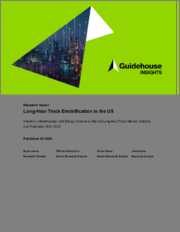
|
시장보고서
상품코드
1555421
미국의 장거리 트럭 전기화Long-Haul Truck Electrification in the US: Adoption, Infrastructure, and Energy Impacts on the US Long-Haul Truck Market, Analysis and Forecasts, 2024-2033 |
||||||
업계 전문가들은 장거리 트럭은 구매 비용이 높고 충전 인프라가 갖추어지지 않아 마지막으로 전기화되는 자동차 분야 중 하나가 될 것으로 예상하고 있습니다. 2023년 미국의 세미트럭 판매량 12만 5,000대 중 EV는 불과 500대에 불과했습니다. 향후 10년간 캘리포니아 주 선진 클린트럭 규제와 같은 주 수준의 제로 배출 차량 판매 의무화가 전동 세미트럭 판매의 주요 촉진요인이 될 것으로 보입니다. 2035년 이후에는 배터리 비용 절감과 충전 인프라 정비가 판매 촉진요인이 될 전망입니다.
경로 중 충전을 위한 전력 공급이라는 과제는 거리 충전 포트의 수와 정격 용량에 대한 불확실성이 높다는 것을 의미합니다. 한 시나리오에서는 트럭 스테이션에는 메가와트급 초고속 충전 설비만 있고, 충전에는 디젤 탱크로의 급유와 같은 정도의 시간이 걸립니다. 또 다른 시나리오에서는 주행중인 트럭용 메가와트급 충전기와 장시간 주차하는 트럭용 저속 충전기를 결합합니다. 장거리 전기화를 배포하려면 이 문제를 해결할 뿐만 아니라 전동 세미트랙에 필요한 트랙 스테이션 수를 결정해야 합니다.
본 보고서는 미국의 장거리 트럭 운송 시장과 향후 10년간의 전기화 가능성을 분석했습니다. 미국에서의 2024년부터 2033년까지의 장거리 트럭의 배치·판매 예측을 파워트레인별, 지역별로, 또, 동시기의 전기화된 장거리 트럭 운행을 서포트하기 위해서 필요한 충전 인프라와 에너지의 예측을 지역별·이용 사례별로 나타내고 있습니다.
목차
제1장 주요 요약
- 장거리 충전 인프라
- 장거리 전화의 영향
제2장 시장 문제
- 성장 촉진요인
- 정책상의 의무
- 비용 절감
- 억제요인
- 구입 가격
- 인프라
- 생산 능력의 한계
- 차량 중량
제3장 업계의 밸류체인
- 경쟁 구도
- 수소 연료전지 트럭
- 기업 합병·인수(M&A) 활동
- 비즈니스 모델의 진화
제4장 시장 예측
- BEV 도입
- 개인 소유 트럭
- 개인 소유의 장거리 트럭의 주행 대수
- 개인 소유의 장거리 트럭의 판매 대수
- 플릿 소유 트럭
- 플릿 소유의 장거리 트럭의 주행 대수
- 플릿 소유의 장거리 트럭의 판매 대수
- 장거리 트럭 충전용 에너지 사용량
- 장거리 트럭용 충전 포트의 도입 상황
제5장 결론 및 제안
- 3개의 큰 포인트
- 추천 사항
- 플릿 매니저
- OEM
- 트랙 스테이션 오퍼레이터
- 유틸리티
- 정부기관
제6장 두자어 및 약어 일람
제7장 목차
제8장 도표
제9장 조사 범위, 정보 출처와 조사 방법, 주석
JHS 24.09.24Industry experts expect long-haul trucks to be among the last automotive sectors to electrify due to their high purchase cost and the lack of available charging infrastructure. In 2023, only 500 semitruck sales out of 125,000 in the US were EVs. Over the next 10 years, the primary driver for electric semi sales will be state-level zero emissions vehicle sales mandates such as California's Advanced Clean Trucks regulation. After 2035, sales are likely to be driven by reductions in battery costs and a more established charging infrastructure.
The challenge of providing power for en route charging means a high level of uncertainty around the number of corridor ports and their rated capacity. Under one scenario, truck stops would only have ultrafast megawatt charging, and charging would take a similar amount of time as refueling a diesel tank. Another scenario would entail a combination of megawatt chargers for trucks continuing on their way and slower chargers for trucks parking for longer periods. Rolling out long-haul electrification will require addressing this challenge as well as determining the number of truck stops necessary for electric semis.
This Guidehouse Insights report analyzes the US long-haul trucking market and its potential for electrification over the next decade. It provides deployment and sales forecasts for long-haul trucks in the US from 2024-2033, broken down by powertrain and region, and forecasts for the charging infrastructure and energy needed to support electrified long-haul trucking operations for the same time period, broken down by region and use case.
Table of Contents
1. Executive Summary
- 1.1 Long-Haul Charging Infrastructure
- 1.2 Long-Haul Electrification Impacts
2. Market Issues
- 2.1 Drivers
- 2.1.1 Policy Mandates
- 2.1.1.1 Advanced Clean Trucks
- 2.1.1.2 Advanced Clean Fleets
- 2.1.2 Cost Reductions
- 2.1.1 Policy Mandates
- 2.2 Barriers
- 2.2.1 Purchase Price
- 2.2.2 Infrastructure
- 2.2.2.1 Market Manipulation
- 2.2.3 Limited Production Capacity
- 2.2.4 Vehicle Weight
3. Industry Value Chain
- 3.1 Competitive Landscape
- 3.1.1 Hydrogen Fuel Cell Trucks
- 3.1.2 M&A Activities
- 3.1.3 Business Model Evolution
4. Market Forecasts
- 4.1 BEV Adoption
- 4.2 Individually Owned Trucks
- 4.2.1 Individually Owned Long-Haul Trucks in Service
- 4.2.2 Individually Owned Long-Haul Truck Sales
- 4.3 Fleet-Owned Trucks
- 4.3.1 Fleet-Owned Long-Haul Trucks in Service
- 4.3.2 Fleet-Owned Long-Haul Truck Sales
- 4.4 Energy Use for Long-Haul Truck Charging
- 4.5 Charging Port Deployment for Long-Haul Trucks
5. Conclusions and Recommendations
- 5.1 Three Big Takeaways
- 5.2 Recommendations
- 5.2.1 Fleet Managers
- 5.2.2 OEMs
- 5.2.3 Truck Stop Operators
- 5.2.4 Utilities
- 5.2.5 Government Agencies



















